Friday, September 29, 2006
Flugkapitan Wendelin Trenkle 1912-
 During the 1930's Trenkle was a flying instructor with the Luftwaffe and in 1937 he became Chief Test Pilot of the Messerschmitt-Zwigweks where he test flew the first ME-108 to be produced and went on,during WW11,to test fly the ME-109 and ME-262. In 1945 he claimed to have shot down a P-38 Lightning. It was during this test flying service that in 1942, Trenkle was granted the title of Flugkapitan at the age of 30, the youngest age at which this honour was ever granted.
During the 1930's Trenkle was a flying instructor with the Luftwaffe and in 1937 he became Chief Test Pilot of the Messerschmitt-Zwigweks where he test flew the first ME-108 to be produced and went on,during WW11,to test fly the ME-109 and ME-262. In 1945 he claimed to have shot down a P-38 Lightning. It was during this test flying service that in 1942, Trenkle was granted the title of Flugkapitan at the age of 30, the youngest age at which this honour was ever granted.
Tuesday, September 26, 2006
Bill Weaver 1930-2021
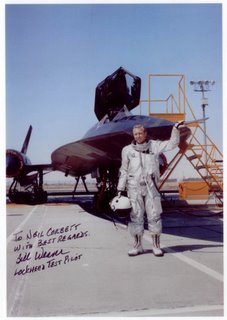
Bill Weaver has flight-tested all models of the Mach-2 F-104 Starfighter and the entire family of Mach 3+ Blackbirds-the A-12, YF-12 and SR-71. He subsequently was assigned to Lockheed's L-1011 project as an engineering test pilot, became the company's chief pilot. He later retired as Division Manager of Commercial Flying Operations. He still flies Orbital Sciences Corp.'s L-1011, which has been modified to carry the Pegasus satellite-launch vehicle. And as an FAA Designated Engineering Representative Flight Test Pilot, he's also involved in various aircraft-modification projects, conducting certification flight tests.
Description of the loss of the SR-71A piloted by Bill Weaver which broke up at Mach 3 and 70,000ft
Loss #4 61-17952 (SR-71A) This aircraft disintegrated on 25 January 1966 during a high-speed, high-altitude test flight when it developed a severe case of engine un-start. This flight was to research and improve high mach cruise performance by reducing trim drag which would lower fuel burn and increase range. The un-start occurred during a turn at speeds above Mach 3.17 and a bank of 35 degrees. The bank immediately increased to 60 degrees; the nose pitched up and the aircraft broke apart at station 720. Lockheed pilot Bill Weaver was thrown clear (his ejection seat never left the plane) and he blacked out during the accident but recovered and landed on the ground safely. Tragically, his Reconnaissance System Officer (RSO), Jim Zwayer did not survive the high-G bailout . It is believed he died instantly from a broken neck before he ever became separated from the aircraft. His parachute opened normally and his body landed close to Bill Weaver's landing position. The incident occurred near Tucumcari, New Mexico with the crash scene being the Mitchell Ranch. The remains of #952 lie buried near the riding stables at Edwards AFB, Ca.
Ivan C Kincheloe Jr 1928-1958
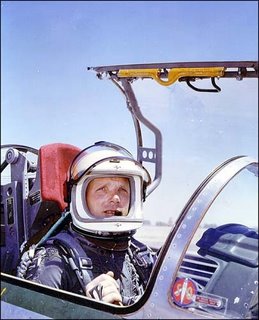
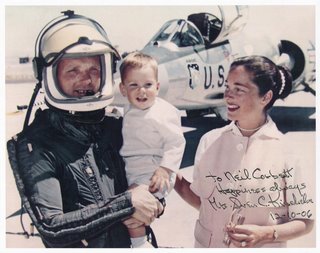
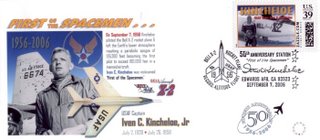
Iven Carl Kincheloe, Jr., was born in Detroit on 2 July 1928. As a boy, he loved to make and fly model airplanes and had decided upon a career in aeronautics by the time he entered high school. He started flying lessons at age fourteen, soloing as soon as the law permitted, age sixteen. He enrolled in Purdue University, Indiana, where he majored in aeronautical engineering and joined the ROTC. In the summer of 1948, as an ROTC cadet, he had the chance to meet Chuck Yeager and sit in the cockpit of the Bell X-1.
He graduated in 1949 and enlisted the Air Force. He was commissioned a second lieutenant and received his wings on 4 August 1950. He spent a year on the F-86E project, testing it at Edwards AFB where he continued to make his mark in the tightly-knit test pilot fraternity.
Upon arriving in South Korea in September 1951, Kincheloe was a first lieutenant. Mostly his unit (the 4th FIW) flew escort missions, protecting the B-29's and RF-80's from the MiG fighters. He flew sixteen missions before he even fired at an opponent.
Kincheloe was quickly recognized as a rare talent, and was transferred to the 25th Fighter-Interceptor Squadron, 51st Fighter-Interceptor Wing, flying F-86Es. This was the model he had tested back in the States; it offered better maneuverability with its all-flying tail and power-aided controls. His personal Sabre was named "Ivan" - unclear whether it referred to his own name (mis-spelled) or to the russian MiGs he faced. He damaged a MiG-15 in his first combat, on 6 January 1952, and downed another MiG near Uilu on the 19th, when he led four F-86's in an attack against ten or more MiGs. He got one, his flight routed the rest, and he earned promotion to captain and a DFC for the mission. His luck then turned sour. In five consecutive fights from 25 January to 27 February he could claim no more than a damaged, while other 25th Squadron pilots were scoring several victories. (Presumably the 'damaged' was on Feb. 2, which some sources note as a confirmed kill.)
Then came April. On the 1st, Kincheloe was flight commander on an escort mission over Yongsansi. Sixteen MiGs attacked. In the dogfight, "Kinch" shot down the enemy leader, took some damage to his own plane, and then got a second MiG, a rare double. He bagged another the next day near Uiju, and made his fifth in the same locale on the 6th. He had destroyed four MiG-15s in six days - a rare achievement. With this mission, he became an ace and earned the Silver Star. In May, he finished his tour in Korea with 131 combat missions behind him, 101 in F-86's and 30 in F-80's.
For his first post-war assignment, he taught gunnery at Nellis AFB, but continually lobbied for coveted test-flight assignments. In January, 1954, he was accepted into an exchange program with the RAF, that got him into the highly regarded Empire Test Pilot's School at Farnborough. This training qualified him as a test pilot and he entered the USAF Fight Test Center in early 1955. He participated in testing the "Century" series aircraft: the F-100 Super Sabre, the F-101 VooDoo, the F-102 Delta Dart, the F-104 Starfighter, the F-105 Thunderchief, and the F-106 Delta Dagger.
In the mid-Fifties, the hottest, most sought after test assignments, the pinnacle of the test pilots' pyramid was the X series of rocket-powered test planes. Following Bell's X-1, the swept-wing X-2 was far beyond its predecessor's capabilities. Constructed of stainless steel and K-Monel copper-nickel alloys, it had a larger rocket motor and was designed to explore atmospheric flight at much greater speeds and altitudes. When the X-2 project pilot, Lt. Col. Frank K. "Pete" Everest, chose Kincheloe as chase pilot, Kinch knew this was his oportunity. Before long, the X-2 program slowed down, and Everest was reassigned. Kincheloe and Captain Mel Apt were selected to continue the program and push the X-2's speed and altitude envelopes. Not long after Everest departed Edwards in June 1956, Kincheloe made two familiarization flights in the single-seat plane.
On Sept. 7, 1956, he rode the X-2 up to 126,000 feet, becoming the first human ever to fly above 100,000 feet. The public reaction to this feat was immense. Although that altitude was about half of what was later considered the edge of space, Kincheloe was immediately hailed as "The first of the spacemen" by a fascinated press and was awarded the Mackay Trophy. Three weeks later Mel Apt was killed in the X-2, minutes after becoming the first man to exceed Mach 3. That abruptly ended the X-2 program. There would be no more rocket plane research until the start of the hypersonic X-15, three years later.
Selected as one of the first three X-15 pilots, he was killed in the crash of an F-104A at Edwards AFB on 26 July 1958
Air Commodore Arthur Edmund Clouston 1908-1984



Having learned to fly in his native New Zealand, he joined the RAF on a short service commission and was posted to No 3 FTS at Grantham (Spittlegate). Joining 3 FTS on the same course as K B B Cross (later ACM Sir Kenneth), he was promoted to the senior term after only 2 - 3 hours owing to his previous experience. Posted to No 25 Squadron flying Fury I's at Hawkinge, he spent the next three years there before moving to No 24 Squadron at Hendon. No 24 was classed as a Communications squadron and carried out a wide range of duties from refresher flying training to VIP transport using a multitude of aircraft types.
When his SSC ended in 1935 he was offered a permanent commission, but turned it down having already decided to forge a career in civil flying back home in New Zealand. However, these plans changed when having transferred to the RAFO, he was offered one of the two newly created posts of civilian test pilots at the RAE Farnborough. During his time at Farnborough he carried out tests into the effects of wires on aircraft and countermeasures against them, as in the case of barrage balloons as well as conducting test flights examining the effects of ice accrual on aircraft flying surfaces. In his own time he also found time to establish a number of distance records including a flight to Cape Town (from Croydon) between 14 and 20 November 1937, with Betty Kirby-Green, in a flight time of 17 hours 28 minutes and the following year he set a record for a return flight from London to New Zealand of 10 days 21 hours 22 minutes. Just prior to WW2, he was attached to Westlands in a private capacity by AVM Tedder, to carry out tests on the new twin engined fighter, the Whirlwind.
Recalled to duty on the outbreak of WW2, in the rank of Acting Squadron Leader, he continued research flying, including tests into the possibility of using flares to illuminate enemy bombers to enable night fighters to make interceptions. In order to gain a better understanding of the problems involved in night fighting, he requested an attachment to a operational squadron, serving with 219 Squadron from Redhill for a month. Further tests in the night fighting sphere followed his return to Farnborough when he was tasked with carrying out trials with the Turbinlite, designed by Air Commodore Helmore and fitted into the nose of Douglas Boston.
Having also carried out tests with the Leigh Light and badgered the authorities to give him an operational posting, it was fitting that he should be given command of No 224 Squadron, a Liberator anti-submarine unit based at Beaulieu. After nearly a year in command of 224, he was promoted Group Captain and appointed CO of the still incomplete Coastal Command station at Langham in Norfolk. Here he was responsible for two Beaufighter strike squadrons, No 455 (RAAF) and No 489 (RNZAF). With the end of the war, he was posted to Germany to command the airstrip, B151, later renamed Buckeburg and expanded, the base would become the headquarters of the British Air Forces of Occupation.
It was whilst at Buckeburg he was offered a permanent commission in the RAF, which he accepted. However, also at this time he was offered the post of Director-General of Civil Aviation in New Zealand. Replying that he was interested but would need Air Ministry approval, the New Zealand government formally announced his appointment, which resulting in the Air Ministry refusing to release him. Possibly as a consolation, he received a secondment to the RNZAF for two years as CO of RNZAF Ohakea. With his experience as a test pilot, it was highly appropriate that in 1950 he should be appointed Commandant of the Empire Test Pilots School, a post he held for three years. Promoted Air Commodore, he returned to the East as AOC Singapore for three years before once again returning the world of aircraft testing as Commandant of the Aeroplane and Armament Experimental Establishment at Boscombe Down.
Wednesday, September 20, 2006
Phillip M Prophett 1917 - 1999


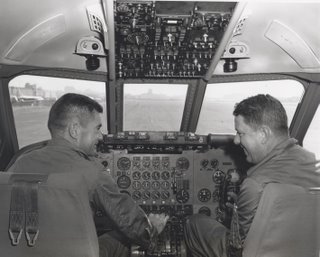 Convair Test Pilots Don Germeraad(left) and Phil Prophett in the cockpit of the Convair CV880
Convair Test Pilots Don Germeraad(left) and Phil Prophett in the cockpit of the Convair CV880
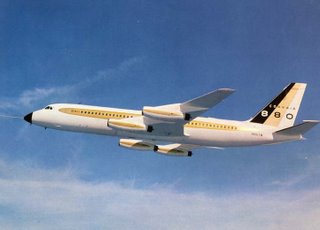 Maiden flight of the Convair CV880 with Don Germeraad and Phil Prophett
Maiden flight of the Convair CV880 with Don Germeraad and Phil Prophett
Phil Prophett was born in
He was involved in several of Convair's aircraft test programs, including late models of the B-24 bomber, the CV-340 and CV-880 airliners, the giant XC-99 transport, and the B-36 and the XB-46 jet bombers. In 1954 he was named Convair's chief of F-102 / F-106 interceptor flight test at Edwards, and later ran tests of those fighters' air-to-air missile systems at Holloman. By 1961 he was Convair's Chief of Engineering Flight Test, and had over 7,000 hours of flight time.
Prophett was moved to the Atlas ICBM program in 1961 to take over the base activation program, which was in crisis. He saw the first ICBM through completion of deployment by 1963, followed by its rapid deactivation. He left the Atlas program in 1966, becoming Convair's director of international sales. Prophett retired in 1977.
Ellis D 'Sam' Shannon 1908 - 1982
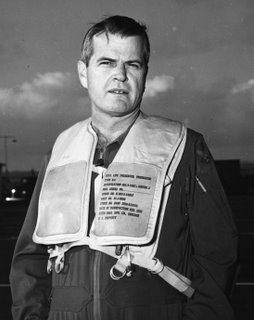

Convair Chief Test Pilot Ellis D. 'Sam' Shannon
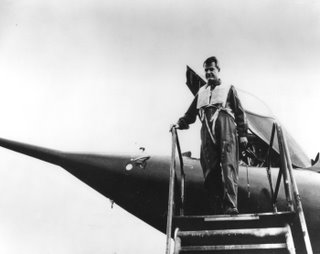 Sam Shannon exiting the Convair XF2Y Seadart after the maiden flight
Sam Shannon exiting the Convair XF2Y Seadart after the maiden flight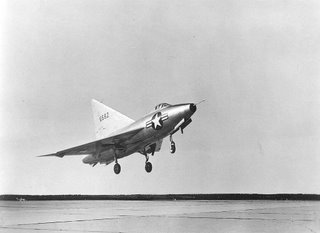 Sam Shannon performed the maiden flight of the Convair XF-92A at Edwards AFB
Sam Shannon performed the maiden flight of the Convair XF-92A at Edwards AFB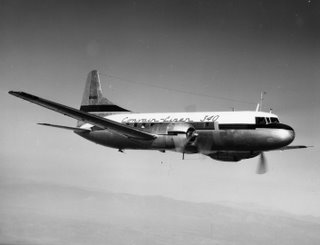 Maiden flight of the Convair CV340, flown by Sam Shannon and Phil Prophett
Maiden flight of the Convair CV340, flown by Sam Shannon and Phil Prophett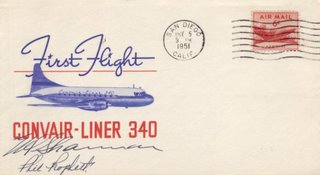
Ellis D. 'Sam' Shannon was born in Andalusia, Alabama,and began his aviation career in 1929 when he joined the Army AirCorps. During 1930-1932, he flew a number of different airplanes, including the old Keystone bombers. In the latter part of 1932, he went to China to train Chinese pilots for General ChiangKaishek. He served for three years as an aviation instructor and assistant advisor to the National Government of China.
He went to work for the Martin Company in 1936, and for the next two years Sam was in Mexico and Central and South America,flying, demonstrating, and instructing on the Martin Model B-10. In 1940, Sam was selected to head Engineering Flight Test for the Martin Company, and between 1940 and 1943 he tested the Martin Baltimore twin-engine bomber, Martin B-26 (which he flew 560 miles per hour during one test, an amazing speed for 1941) and then did most of the development flying on the Martin PBM3 and about half the development flying on the Martin Mars.
In February 1943, he came to Consolidated Vultee(later Convair) as Chief of the newly-established Flight Research Department. From 1943 until the end of the war in 1945, he flew nearly every airplane developed at San Diego, various models of the B-24,including the B-24K, and the PB4Y-2. He also flew the XP4Y-I (Model 31), XB-32, and RY-3. He was also at the Nashville Division flying the early A-31.
Near the end of the war, he flew the Model 39, and also made some flights on the XP-81 at Muroc. He made the first flight of the four-engine jet XB-46 and about half the total test program on that aircraft. Shortly after WWII, he flew experimental aircraft suchas the Stinson Voyager, Stinson Skycoach, Spratt Conntrollable Wing,and Gwinn Aircar. In 1947, Sam flew the Model 110 (prototype to the Convair 240), and the Model 340, which followed in 1948.
In September of 1948, Sam made the first flight of the XF-92A, becoming the first person to fly a delta wing aircraft. He was also active in the development testing of the XL-13. In 1950, he flew the XP5Y-1, and the following year was active in the development and certification of the Convair 340. The following year, he flew the XF2Y-1, the Sea Dart, the first Navy delta wing seaplane, and in 1954 participated in the early development of the F-l02. In 1955, Shannon did open-sea testing with the SeaDart, evaluating both the single-ski and twin-ski configurations. That was the last intensive testing for Sam. In October 1956, he officially retired from test flying.
Eric George Franklin OBE DFC AFC 1920-

 Prone Meteor
Prone Meteor AW Apollo
AW Apollo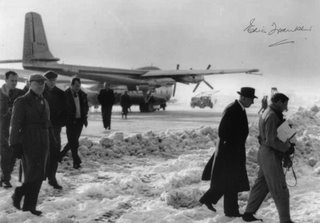 Eric Franklin walks from AW Argosy G-AOZZ after the maiden flight
Eric Franklin walks from AW Argosy G-AOZZ after the maiden flight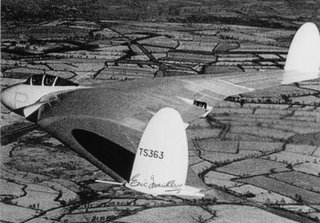 Eric Franklin performed the maiden flight of the AW52 Flying Wing in 1947
Eric Franklin performed the maiden flight of the AW52 Flying Wing in 1947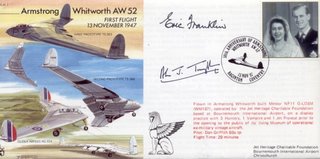
Eric Franklin was Apprenticed to Armstrong Whitworth in 1937 and in 1938 learned to fly under the Civil Air Guard Scheme on a DH60X Moth. In 1939 he qualified for Royal Aero Cub Certificate.In 1939 he joined the RAF Volunteer Reserve (RAFVR) and continued flying training at No 9 Elementary and Refresher School on Avro Cadets and Hawker Harts. He was mobilised on the outbreak of war.
In 1940 he was posted to 10 Operational Training Unit Abingdon and No 19 OTU Kinloss on Amstrong Whitworth Whitleys. He was later that year posted to Bomber Command flying with 78 Squadron flying Whitley aircraft on ops over Europe. In 1941 he was posted to 35 Squadron to fly Halifaxes from Linton-on-Ouse on raids on the Ruhr, Hamburg and Berlin. Between 1941 and 1942 he helped formed Halifax conversion Flights at Linton-on-Ouse, Leconfield and Marston Moor. In 1942 he was seconded to Handley Page as a Halifax Production pilot. In 1943 he was posted to 35 Squadron as Flight Commander flying halifaxes as part of the Pathfinder Force from Graveley. He was then posted to Telecommunications Flying unit flying Lancaster, Mosquito and Beafighters.
1944-1945 he attended the Empire Test pilots school at Boscombe Down. In 1945 prior to his demobilisation he was seconded to Armstrong Whitworth Aircraft for experimental test flying with the Chief Test Pilot Charles Turner Hughes on AW52G glider and production tests on Lancaster and Lincoln. in 1947 he was apponted Senior test pilot and on 13th November he flew AW52 on it's First Flight. In 1948 he was appointed Chief Test Pilot and continued in that role until 1965 where he was flying various aircraft produced at Baginton including several meteor marks, Sea Hawks, Hunters and Javelins. On the 10th April 1949 he captained the Apollo turboprop airliners in its maiden flight. On 31st May 1950 he flew prototype Meteor NF11 on its first flight and later in 1959 captained the Argosy on its maiden flight. In 1965 following the closure of Baginton he moved to Hawker Siddeley Aviation in Manchseter and undertook development and production tests on Avro 748 Shakleton AEW and Nimrod.










